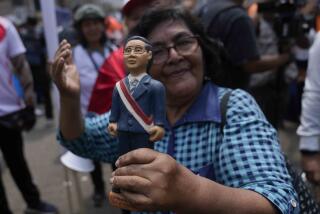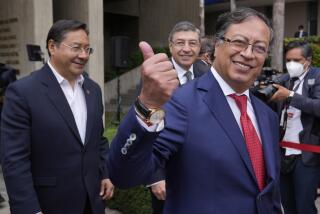Peru’s Unshackled Media Take First Steps Toward Free Press
- Share via
LIMA, Peru — Defenders of press freedom have invented a term to describe media repression in Peru: “infotatorship.”
Coined by the U.S.-based Committee to Protect Journalists, or CPJ, the word suggests a postmodern dictatorship based on control of information rather than on mass murder, “disappearance” of dissidents and other methods of yore.
There have been moments during this landmark year when a bit of channel-surfing was enough to understand the concept. On the night of the April election here, as crowds converged on the presidential palace to denounce alleged vote fraud, half a dozen television channels simply ignored them. Instead, the stations broadcast their usual fare: soap operas, lurid reality talk shows, crass comedy programs and reruns of U.S. cop dramas such as “The Streets of San Francisco.”
Only Canal N, an all-news cable channel launched last year by the newspaper El Comercio, provided exhaustive coverage of the protests. Only Canal N opened a window onto reality during the troubled election and ensuing turmoil that culminated last month with the fall of Vladimiro Montesinos, the all-powerful spy chief.
But only about 10% of Peru’s population of 27 million can afford cable television. The rest were subjected to a systematic strategy of media manipulation that was masterminded, according to Peruvian and foreign critics, by Montesinos and his National Intelligence Service, or SIN.
“When our channel was born, the control of the media became more evident,” said newsroom chief Rolando Chumpitazi, 30, a senior member of the baby-faced journalistic team at Canal N. “It got worse during the elections when the media shut out the [opposition] candidates. We weren’t created to act as the opposition. But we have ended up defending and reinforcing democracy.”
As Peruvians prepare for elections next year that will replace President Alberto Fujimori, signs of change have come to television screens and newspapers in Peru. Talk shows on pro-Fujimori stations have featured first-time interviews with outspoken leaders of the opposition. A new independence has crept into news programs that only a few weeks ago were seen as so slavish toward the government that students heckled their camera crews in the streets.
But the transition has a way to go. Press advocates say Fujimori’s 10-year regime had become the most hostile to journalists in Latin America outside Cuba. Scores of journalists had their phones tapped, were imprisoned on dubious charges and even suffered violent attacks, according to the CPJ.
The written press has remained more independent than non-cable television, which reaches a far larger audience. And Fujimori, who insists that he wants a free press, has demonstrated media savvy and accessibility in his dealings with foreign and Peruvian media alike.
The existence of Canal N shows that Peru is not Cuba. The director is Gilberto Hume, a Peruvian who made his mark as a correspondent for Spanish-language television networks based in the United States.
Hume assembled a team of reporters and anchors in their 20s, intentionally seeking fresh faces for a station that serves as a kind of front-line journalism academy. Lightweight cameras, intrepid motorcyclists and an enthusiastic esprit de corps give the operation speed and agility.
“Our idea is that everyone is a journalist: the driver, the technician, the cameraman,” Chumpitazi said.
Canal N reaches an estimated 300,000 households. It enjoys almost heroic status for its work: At one point during the elections, campaign workers for opposition candidate Alejandro Toledo set up a giant screen in a poor neighborhood so people could watch unbiased coverage.
With the departure of Montesinos, the worst moments of repression appear to have passed. But staff members at Canal N remain cautious. They would top the target list in the unlikely, but not impossible, event of a coup attempt. So a camera is permanently pointed at the well-secured front entrance, ready to beam the images to the world if the soldiers come to shut them down.
More to Read
Sign up for Essential California
The most important California stories and recommendations in your inbox every morning.
You may occasionally receive promotional content from the Los Angeles Times.













